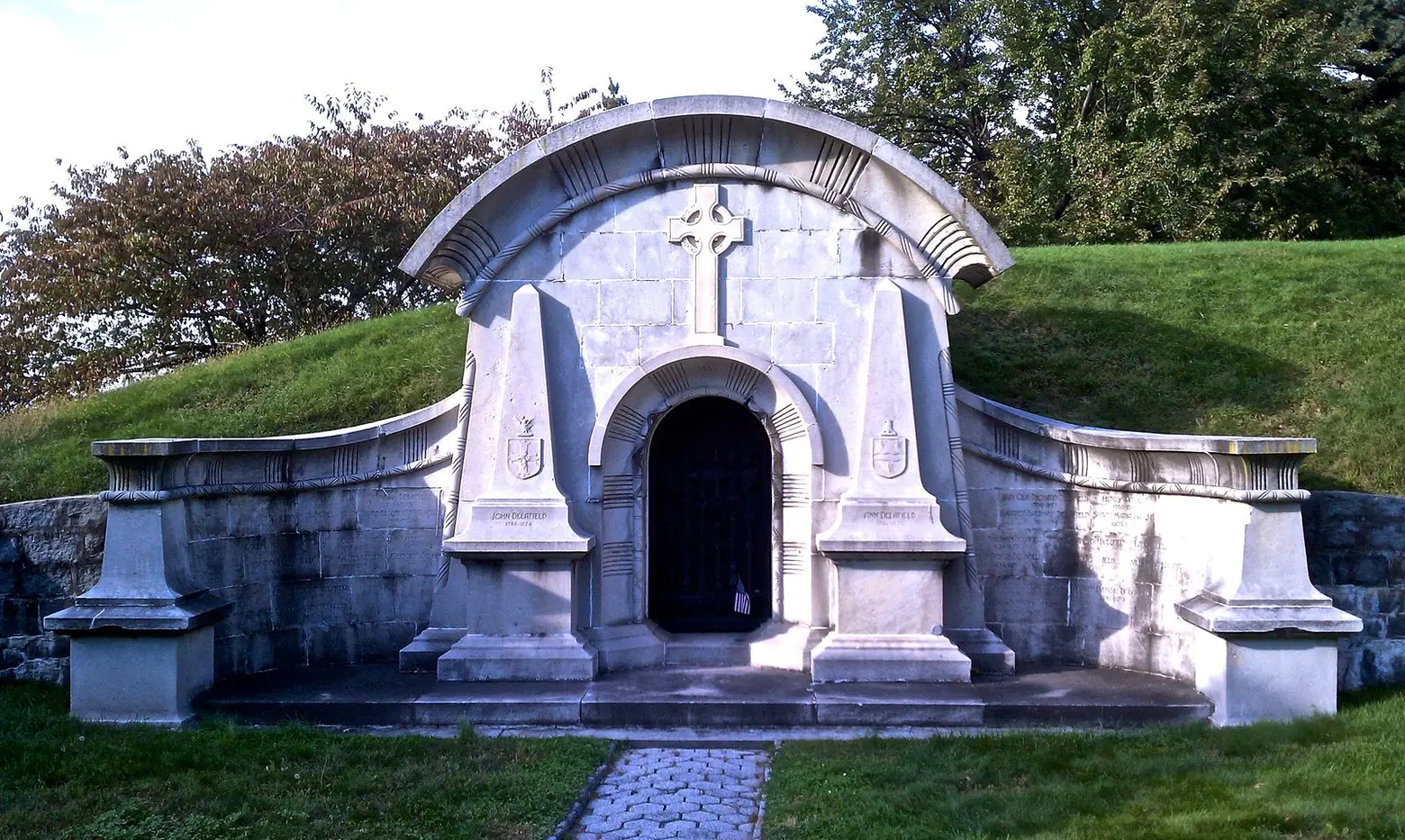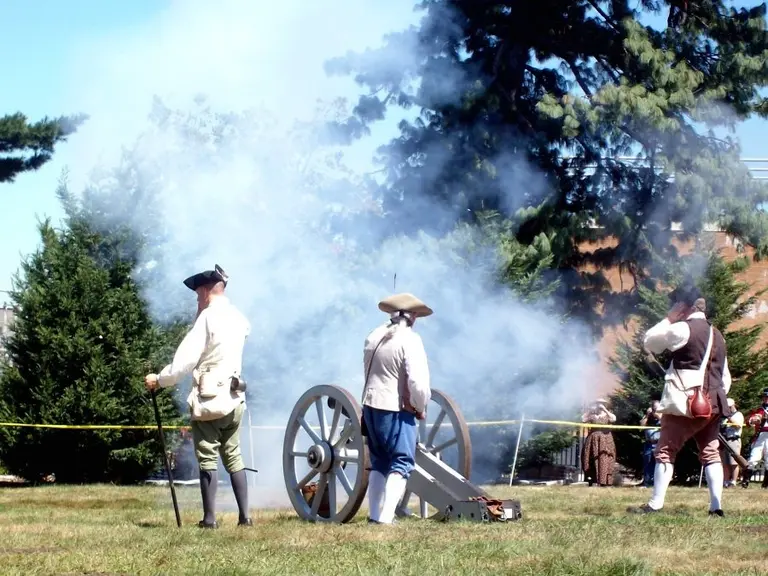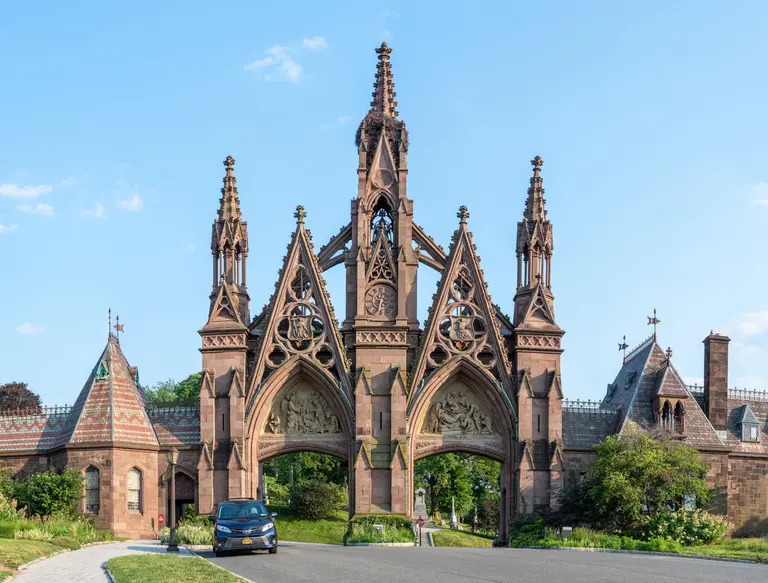10 things you didn’t know about Green-Wood Cemetery

Photo by Eden, Janine and Jim on Flickr
What do Jean-Michel Basquiat, F.A.O Schwarz, Horace Greeley, Samuel Morse, Louis Comfort Tiffany, Boss Tweed, Peter Cooper, Leonard Bernstein, and Susan Smith McKinney-Steward have in common? All these notable New Yorkers are spending eternity in Brooklyn, specifically Green-Wood Cemetery, the stunning 478-acre “rural cemetery” that’s home to 560,000 “permanent residents” (and about as many truly spectacular mausoleums.) Since the best secrets are the ones you take to the grave, come dig up the dirt on Green-Wood, and read on for 10 things you didn’t know about Brooklyn’s most sensational cemetery.

“Green-Wood Cemetery, New York” c. 1875, via NYPL Digital Collections
1. It was once NYC’s biggest tourist attraction
When we say it’s a sensational cemetery, we mean that it was literally a sensation in mid-19th century New York. Since Green-Wood opened in 1838, well before either Central or Prospect Parks, it stood out as one of the first landscaped public sites in New York. Accordingly, New Yorkers were drawn to it in the same way that they would later be to the parks. Day-trippers and tourists came to picnic and walk the shaded winding paths of Green-Wood. In fact, by 1860, the cemetery welcomed over 500,000 visitors per year, making it the second most popular attraction in all of New York State. (Niagra Falls took the top spot.)

Photo by Chun Yip So on Flickr
2. Major engineers and architects are responsible for its design
It’s no accident that Green-Wood held such a prominent place in 19th-century New York. It was designed by some of the era’s heaviest architectural hitters. David Bates Douglas, who designed the cemetery, was also tapped to design the Croton Aqueduct. And the cemetery’s main entrance gate was designed by Richard Upjohn, who also designed Trinity Church.

DeWitt Clinton Monument, by Rhododendrites via Wikimedia Commons
3. DeWitt Clinton put Green-Wood on the map
While Green-Wood was immensely popular with people looking to spend a day, it was much less popular with people looking to spend eternity. When Green-Wood opened, the notion of a cemetery was a largely unfamiliar concept, as people were buried in local churchyards or in potter’s fields. The newfangled idea of a dedicated “cemetery” was off-putting to many New Yorkers who expected to be laid to rest beside a church. Many more turned up their noses at the idea of being buried in Brooklyn, so far from the city as they knew it.
Then came an underground coup, so to speak. Green-Wood’s directors wanted to draw the crowds, and they did it the best way they knew how: by scoring a celebrity. In 1844, they received permission to move the remains of DeWitt Clinton from his original resting place in Albany to Green-Wood. When word got out that Clinton–who was hailed as the father of the Erie Canal and had served as Mayor of New York City, Governor of New York State, and US Senator from New York–was interred at Green-Wood, New York’s most fashionable families turned out in force, buying up plots in what was now the hotspot of the hereafter. In fact, Green-Wood became so fashionable that the New York Times wrote in 1866, “It is the ambition of the New Yorker to live upon Fifth Avenue, to take his airings in the Park and to sleep with his fathers in Green-wood.”

Revolutionary Reenactment on Battle Hill, 2016, by Jim.henderson via Wikimedia Commons
4. Green-Wood is home to the highest natural point in Brooklyn (and it’s got a lot of history)
Green-Wood doesn’t just have high style, it has high elevations. In fact, Green-Wood is home to the highest natural point in Brooklyn, known as Battle Hill. This brings us to George Washington. The “battle” in question was the Battle of Brooklyn (also called the Battle of Long Island) which was the first major battle fought after the signing of the Declaration of Independence. The Battle of Brooklyn began August 27, 1776, and was fought atop Battle Hill, throughout what is now Green-Wood Cemetery into what’s now Prospect Park.

Minerva waving to Lady Liberty, 2009, by Russell Bittner via Wikimedia Commons
5. That history is commemorated by a staring contest between the Goddess of Wisdom & the Statue of Liberty
Because the Battle of Brooklyn was a major defeat for the Continental Army, which ultimately drove Washington out of New York City and turned New York into the British base of operations for the duration of the war, Green-Wood’s Revolutionary bona fides were not commemorated or memorialized until the 20th century.
In 1920, Charles Higgins erected a bronze statue of Minerva, goddess of wisdom and strategic warfare, on Battle Hill. Even better, Minerva intentionally salutes the Statue of Liberty. From the high perch of Battle Hill, you can see across the harbor and witness each great lady saluting Freedom. In 2008, that link was almost severed, when a proposed condo would obstruct the view. But Green-Wood reached an agreement with the developers, and the stare-down has continued unabated ever since.

Green-Wood Civil War Memorial, 2012, by Kenneth C. Zirkel via Wikimedia Commons
6. It also has significant Civil War and WWII history
Green-Wood also serves as the final resting place for 5,000 Civil War dead, both Union and Confederate. A Civil War soldier’s memorial stands on Battle Hill, and since 2002, local volunteers have been working to identify all 5,000 of the fallen soldiers. During WWII, wrought iron fences that ringed some of the most prominent and elaborate graves were melted down for the war effort.

Green-Wood Chapel, 2015, by Beyond My Ken via Wikimedia Commons
7. The chapel is designed by Grand Central Terminal architects, Warren and Wetmore
Interestingly, Green-Wood, founded as a nondenominational cemetery, did not have a chapel on its grounds until 1911, when the firm Warren and Wetmore began construction on the stunning Neo-Gothic building. Warren and Wetmore completed the chapel in 1913, the same year they completed Grand Central Terminal.
8. You too can take secrets to the grave
For the next two decades, Green-Wood visitors can come armed with everything they’ve sworn never to reveal and lay it to rest in a marble obelisk in Green-Wood. The Obelisk is part of a 25-year interactive storytelling project by artist Sophie Calle. She began the project in 2017 when she designed and installed the obelisk. The monument reads, “Here Lie the Secrets of the Visitors of Green-Wood Cemetery.” Below the inscription is a slot where visitors can deposit a slip of paper bearing any secret they wish to take to the grave. Over the course of the project, Calle will return to the cemetery periodically to empty the vault and burn the secrets.

Delafield Family Mausoleum, 2011, by Jbabich21 via Wikimedia Commons
9. Speaking of vaults, some of Green-Wood’s graves were designed to comfort those who feared being buried alive.
The 19th century was rife with epidemics that led to hasty and high-volume burials. As a result, there was a serious and fairly widespread fear amongst the general public of being buried alive. To combat this, Green-Wood helped pioneer a practical and elegant solution. The Burial House was an above-ground tomb in the shape of a small home that made for a beautiful final resting place, with the added perk (should you be buried alive) of not having to claw your way out from underground.

Parrots on the Green-Wood Cemetery Gate, 2017, by Rhododendrites via Wikimedia Commons
10. Green-Wood has some living residents
Since the 1970s, Green-Wood has been home to a cadre of Argentinian monk parrots that have lived on the main gates of the cemetery. If you look up into those Gothic arches you can see the nests. And even if you can’t spot them, you’ll certainly hear them squawking.
RELATED:
- How did a flock of Argentinian parrots land in Brooklyn’s Green-Wood Cemetery?
- The Battle of Brooklyn 242 years later: Where the fighting played out in present day
- 10 things you never knew about Prospect Park
Editor’s note: The original version of this post was published on October 21, 2019, and has since been updated.
+++
 Lucie Levine is the founder of Archive on Parade, a local tour and event company that aims to take New York’s fascinating history out of the archives and into the streets. She’s a Native New Yorker, and licensed New York City tour guide, with a passion for the city’s social, political and cultural history. She has collaborated with local partners including the New York Public Library, The 92nd Street Y, The Brooklyn Brainery, The Society for the Advancement of Social Studies and Nerd Nite to offer exciting tours, lectures and community events all over town. Follow her on Twitter and Instagram.
Lucie Levine is the founder of Archive on Parade, a local tour and event company that aims to take New York’s fascinating history out of the archives and into the streets. She’s a Native New Yorker, and licensed New York City tour guide, with a passion for the city’s social, political and cultural history. She has collaborated with local partners including the New York Public Library, The 92nd Street Y, The Brooklyn Brainery, The Society for the Advancement of Social Studies and Nerd Nite to offer exciting tours, lectures and community events all over town. Follow her on Twitter and Instagram.








































